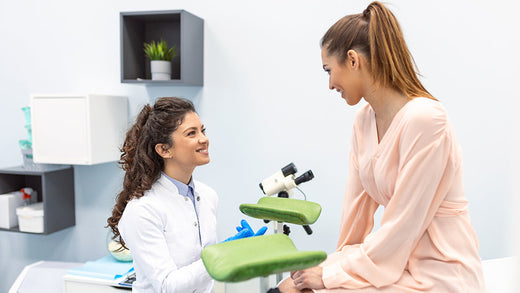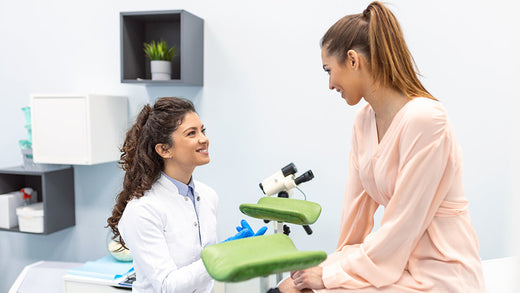Does A Smear Test Hurt?
Find out moreA smear test, also called a cervical cancer screening test, checks the health of your cervix — the opening to your womb from your vagina — to test for a virus called the human papillomavirus (HPV), which can cause cervical cancer to develop. Cervical cancer that has already developed can also be identified during a smear test.
In this guide, we’ll discuss what happens at a smear test, whether or not they hurt, what to do if you experience any side effects and how to best prepare for your next test.
How does a smear test work?
A smear test is a very straightforward procedure that a female doctor or nurse usually performs.
To have the test, you’ll be lying on your back with your clothes off from the waist down. When you’re ready, you’ll need to spread your knees apart, and your doctor or nurse will insert a speculum (a plastic or metal medical tool) into the vagina to open it up, which helps them to see your cervix.
With the speculum in place, they’ll then use a soft, plastic, brush-like tool to take a small sample of cells from the surface of your cervix. The speculum will then be removed, and you can re-dress. The sample will be sent to the lab for analysis.
In the UK, the NHS invites all women between the ages of 25 and 49 to have a smear test every three years, and women aged 50 to 64 are invited to have one every five years.
Women over 65 have a very low chance of developing cervical cancer, so from this age, you’ll only be invited for smear tests if one of your last three tests came back as abnormal.
How long does a smear test take?
A smear test is a very quick procedure. It is usually over and done within less than five minutes, and your whole appointment should take around 10 minutes.
Your nurse or doctor will advise you as to when you should receive your results. It usually takes a few weeks for your sample to be processed.
Your results will be sent to you in a letter, or you may be asked to call your doctor to get your results over the phone.
Does a smear test hurt?
Smear tests are often uncomfortable and can be a little painful for some people. Any pain or physical discomfort you do feel should subside soon after the test has been completed, so it should only last for a few minutes.
Some people may feel embarrassed about going for a smear test, but remind yourself that the nurses and doctors who perform these tests are medical professionals who have done so hundreds, if not thousands, of times.
Certain conditions, such as vulvodynia or endometriosis, or if you’ve been through menopause and experience vaginal dryness, can mean that having a smear test can be painful.
You may also find a smear test uncomfortable if you’ve experienced sexual assault or have had a traumatic medical procedure in the past. Let your nurse or doctor know if you’ve been affected by any of these issues so that they can help you feel more comfortable.
It’s also important to remember that going for your smear tests when you’re invited is the best way to prevent cervical cancer, and any pain you experience during the test will only be temporary.
For women who do find smear tests uncomfortable or painful, Check4Cancer’s Cervical Cancer Screening Test is a fantastic alternative. The reliable and easy-to-use at-home kit doesn’t require an internal examination — only a swab from inside the vagina.
Why am I bleeding after a smear test?
Some spotting or light bleeding is fairly common after a smear test, and you may experience some cramping too. This is because the cervix is very sensitive so that it can be easily irritated by the sample brush.
These side effects should go away after a couple of hours. Get in contact with your doctor or nurse if you have a lot of pain after your test, are still bleeding after a few hours or start to bleed more heavily.
How to prepare for a smear test
There are a few things you can do to help you feel more comfortable during your smear test and reduce the risk of pain.
You may find it helpful to:
- Wear a dress, skirt or long top that you can keep on during the test and raise easily
- Bring a friend or family member to your appointment to offer you support
- Ask to book a longer appointment if you have questions or are feeling nervous
- Request for the test to be done by a female nurse or doctor
- Practice breathing exercises or listen to music to help you relax
- Tell your nurse or doctor about any conditions or concerns you have that may make the test more uncomfortable for you
- Ask if you can lie in a position that may be more comfortable, such as on your side with your knees tucked into your chest
- Ask for lubrication to be applied to the speculum before it’s inserted
- Ask for a smaller speculum to be used
- Put the speculum in yourself
The most important thing to remember is to communicate openly with your doctor or nurse. Make sure you ask them any questions you have before they start the test, and have them talk you through each step of the test if you’re nervous.
If the discomfort or pain you feel is too much to bear, it’s important to tell the nurse or doctor to stop or to perform the test more slowly. You can also ask for the test to be stopped at any time.
Can you do a smear test at home?
If you’d prefer not to have a smear test, an at-home our Cervical Cancer Screening Test is a reliable alternative. As well as being more convenient, it is an easy-to-do and accurate test that you can take in the comfort of your own home.
Our test is so accurate at detecting HPV that the NHS has approved it as a reliable method of cervical cancer screening. In fact, for 90% of women, using our test means you may never need to have a smear test again.

Jullien Brady
Clinical Advisor for Cervical Cancer
Consultant Gynaecologist. Professional Clinical Advisor for Colposcopy for Public Health England. Member of the Executive Committee of the BSCCP. Jullien Brady has an international reputation as a leading expert in the field of colposcopy and cervical screening. He is a former National Quality Assurance Director for the NHS Cervical Screening Programme and Professional Clinical Advisor for Colposcopy for Public Health England. He was a member of the Executive Committee of the BSCCP, the governing body of Colposcopy for over a decade. Mr Brady is passionate about women having the opportunity to maximise their health choices and screening options.
Find out moreKnowledge and support
Go to all articles
HPV Awareness Day
The International Papillomavirus Society (IPVS) established March 4th as HPV Awareness Day, in 2018. It provides an opportunity to highlight...
Read more
What is HPV and What are the Symptoms?
Understanding HPV, how it spreads, its symptoms, and how to protect yourself is crucial for maintaining your health.
Read more
Does A Smear Test Hurt?
What happens at a smear test, does it hurt or not, what to do if you experience any side effects...
Read more